 It seemed like a great idea, plan an event, promote it, have lots of people turn up, deliver some great content and kick start many new beautiful relationships.
It seemed like a great idea, plan an event, promote it, have lots of people turn up, deliver some great content and kick start many new beautiful relationships.
Just one small hurdle to jump, how do you get people to attend? With so many webinars, conferences, trade shows and other events on offer delegates are spoilt for choice.
Let’s start here with planning your email marketing strategy to drive attendance and then I’ll go through 8 example event invitation emails, all annotated to explain the good points of each.
Event planning
Begin planning your email marketing strategy by writing down answers to these questions:
- Exactly why should people attend? What will they gain by investing their time and money?
- Who are you targeting to attend? How do you need to segment your database, geographically, based topics of interest?
- How many emails are needed? Consider the cost and time commitment you are asking from attendees as well as the number of seats you need to fill.
- Timescale and plan? When should you start promoting and what’s the timing for each email?
- How can you keep each email fresh? What different aspects of the event can you talk about?
- What incentives will you offer? Such as a discount for early bookers or group discounts.
- How can you make it easy for speakers and event partners to promote the event?
Remember too to plan on recording the event. Whether an in person or virtual online event, you can double up on the value of the event. The value of the content generated and post event downloads/watches for a virtual event is typically greater than the live event itself. Modern online course platforms provide facilities for streaming and make it easy to reformat for replay.
Promotion timing
Start too soon and people won’t be ready to consider attending, start too late and their calendar is full and budget spent.
If you’re running events periodically then promote the next one immediately after the last one. Attendees who had a good experience will want more. Follow up an event with a thank you email, letting them know the date and theme of the next event.
Begin your main thrust of promotional emails based on how far in advance your target audience plan their time and learning needs. Planning a big in person event with possible travel and hotels involved? Then your audience need longer in advance to plan, they might need time to get budget approval.
If it’s a smaller local event and just a couple of hours out of the attendee’s calendar then four to eight weeks in advance is likely a good choice. A webinar or virtual event could be left a little later still, two to six weeks in advance.
Email campaign sequence
Map out a sequence of emails, with the timing and content for each.
- What different aspects of the event might appeal to different people?
- As planning progresses what additional information will you have during campaigning to share?
- What key insights will attendees benefit from?
- Have you testimonials from previous events?
- Bio’s and pictures of speakers? Particularly if they are known authorities.
- A video from a previous event or a promotional video for the next event?
Here’s an example of a typical sequence to promote a more an event.
| Event concept and major themes decided | Build Initial awareness by incorporating top line details in existing emails such as your regular newsletters. |
| Date and location fixed | Begin dedicated email campaigns and use of early booking incentives |
| Speakers confirmed | Send detail of speakers, their credentials, why they should be listened to and title of their sessions |
| Detail agenda and session takeaways decided | Specific details of what attendees will learn by attending. For webinars and virtual events offer to send a recording to people who register but are unable to attend live |
| Warm prospects extra nudge | Extra email and incentive to nudge people who clicked previously and haven’t booked yet |
| Notable brands attending | Social proof. The brands and job roles of people attending, so that others can identify themselves as in the same peer group. |
| Urgency. Getting close, last places and last call | Urgency to drive action for those still undecided. For virtual and online events last call can be as close a few hours before. |
Make sure you add to your event landing page or website email address capture. Add newly captured email addresses to your house list for event promotion. If you’ve sharable content, such as slide decks and recordings, perhaps from a previous related event, then offer those as an incentive for people to give you their email address it’s a great way to get faster email list growth and signups.
8 event and webinar invitation example emails
This example email invitation for the Conversion Conference has many carefully put together elements, to appeal to different types of people. Some prospects may focus on or recognize the speakers, others may be more interested in the session content and what they can learn. Given its an in person event with a full access two day pass costing $1,800 the event promotion started months in advance.
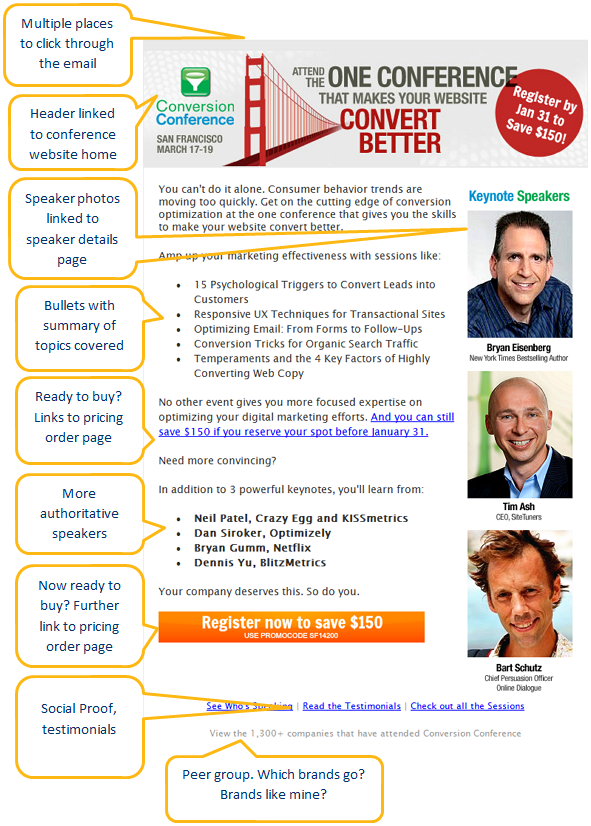
Wistia Webinar email invite, sent just a few days before the scheduled date. The time for the webinar includes the timezone, since they have an international audience.
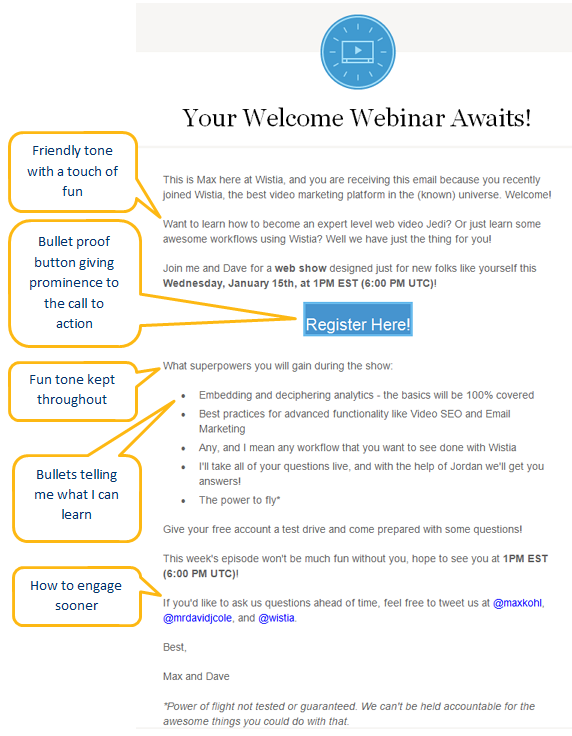
MarketingProfs deliver a variety of events covering many different marketing topics and are thus experienced in promoting and holding events. Their events include both online and in person, this example is for one of their more significant in person events. The example incorporates the call to action three times, which is a good idea, top middle and bottom. In common with all examples the call to action copy is all about register. There is a simple formula to creating call to action copy.

Smart Focus highlight the speaker for this webinar email example, quite understandably since a well known and authoritative speaker is featured. The speaker and subject for the webinar have been chosen to appeal to senior personnel. The creative is striking and very different to most other email invitations. The webinar title is prominent and together with the subhead the reader knows in a split second what’s going on.

This event promotion email from Econsultancy was sent just a week before the event. A long sequence of emails were used to promote the event and this one is all about using social proof. The job titles featured of the people attending have been carefully picked to be senior level position to lend more credibility to the event.
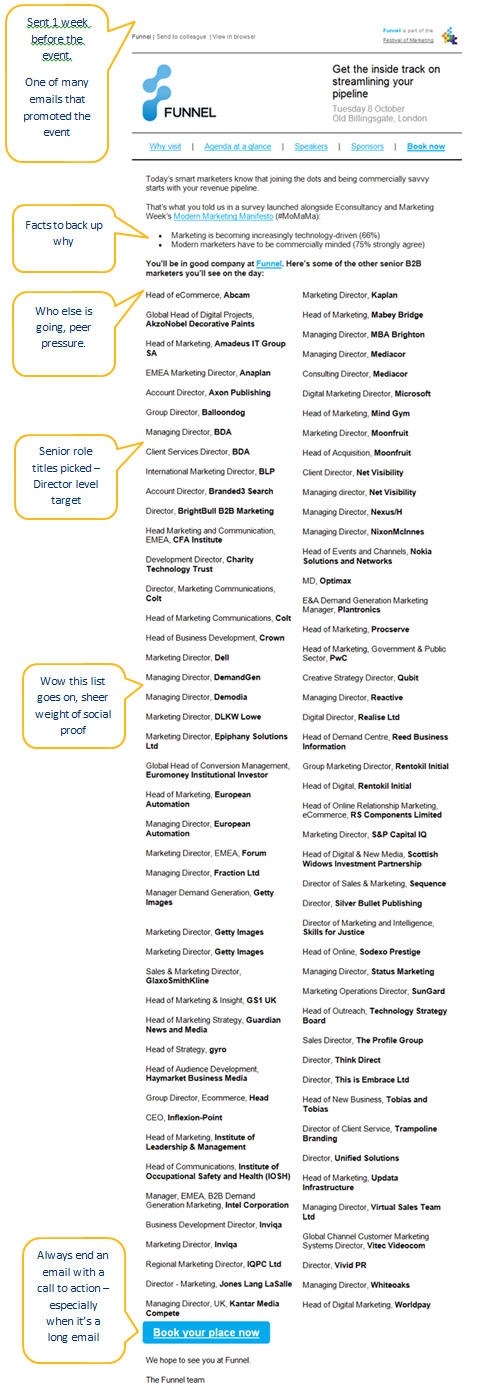
This event email stands out for using a plain text format and written in a personal one-one email style. A plain text email can reach people who are ignoring graphical emails that sometimes scream marketing.
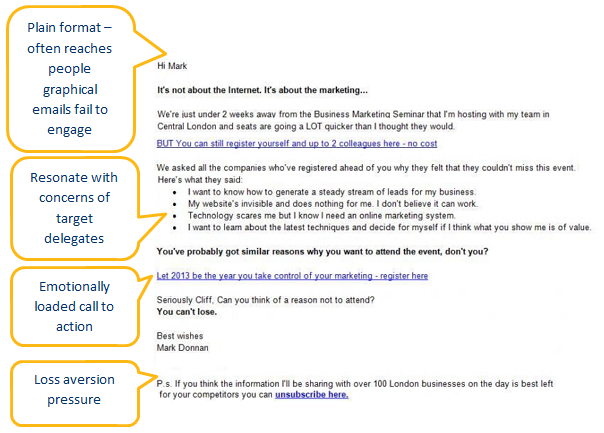
This clean and simple email from Twitter covers all the basics. Also great to see Twitter wisely using email to promote their events!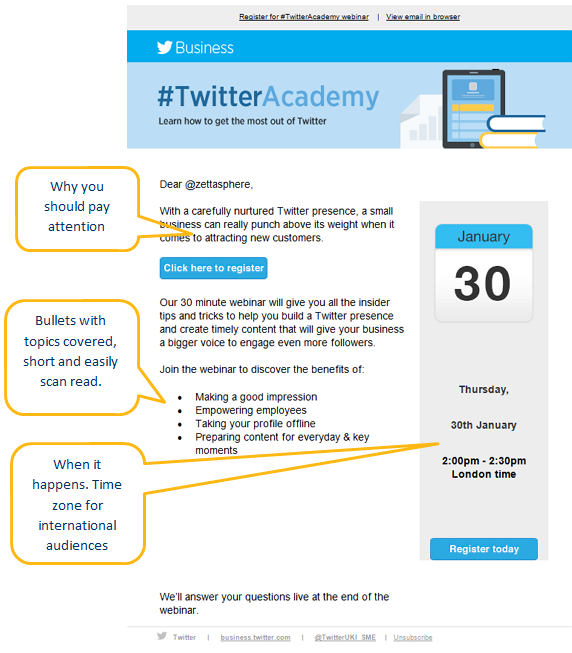
Finally this example email from Volkswagen is included as it is part of a multi-channel campaign. A few days before the email Volkswagen sent out a high end glossy promotional pack via the mail and then followed up with email. A smart choice since multiple touches increases response.
 Once you’ve got your email creative right then work on your subject line. There are quite a few subject line myths around, spam trigger words are no longer the problem they used to be. As spam filtering and deliverability has moved on from content being the cause of being filtered.
Once you’ve got your email creative right then work on your subject line. There are quite a few subject line myths around, spam trigger words are no longer the problem they used to be. As spam filtering and deliverability has moved on from content being the cause of being filtered.
Finally, don’t forget after the event to send out an email to thank people for attendance, provide download links to the event content or recordings and give a next step in the relationship for attendees.
